People often ask if a sales funnel is better than a website and which option suits their business better? Of course, both have pros and cons, and it’s hard to find a general answer. But we’ll give you a definite one:
A sales funnel is not better than a website unless you want to increase sales and conversions quickly. A website should always be your primary marketing tool. It’s cheaper to build, maintain, easy to use and has a long-term ROI. A sales funnel is just a powerful addition to your marketing arsenal.
This article will take a closer look at the core differences between sales funnels and websites. As we examine the pros and cons, we can help you decide which is best for your business.
What Is a Website? – A Quick Recap
A website (in terms of marketing) is the online face of your business, and it’s the foundation of your digital presence. It’s the first place your potential customers will go to learn about your business, its products, and its services. Therefore, most websites are designed to attract customers.
It’s the first step of a sales funnel and the objective is to build trust with them.
Once customers are interested in your products or services, they’ll move further down the sales funnel to learn more and potentially become customers.
You can read my article on ‘How a Sales Funnel Works?‘ to know about all the steps involved.
Keeping that in mind, your website should be designed to convert visitors into leads.
A website that is well-designed, user-friendly, optimized for search engines, and informative can help you achieve that.
It’s also vital for your website to provide valuable content that helps solve the customer’s problems.
When your website achieves this, you’re able to build trust with your prospects.
Potential customers will be more likely to do business with you if they feel confident that you’re a credible company.
A professional website design and effective branding can help create this impression.
Although the specific contents of a website may vary, many well-designed websites have the following sections:
- Home
- About
- Products/Services
- Blog
- Contact information
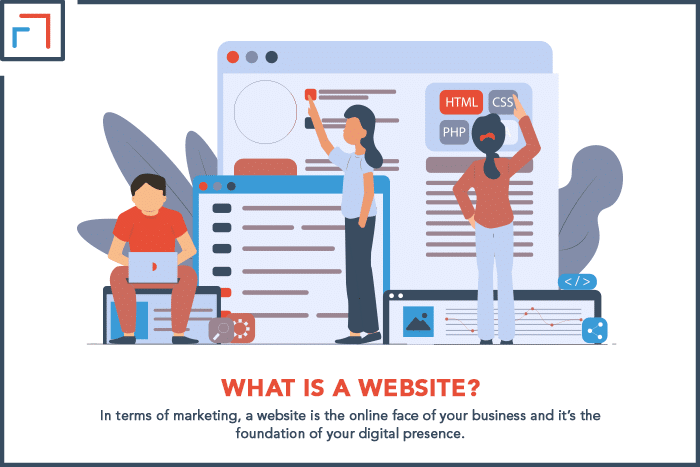
What is a Sales Funnel? – Revise Your Basic Understanding
A sales funnel is a strategic process that takes casual visitors and turns them into paying customers. The primary goal of a sales funnel is to get the maximum number of website visitors through the funnel and convert as many as possible into actual buyers.
Simply put, it’s a series of steps or stages that you put your website visitors through to convert them into customers.
Also, you should know when exactly to deploy a sales funnel for maximum impact.
Many business owners have found that a sales funnel helps them increase sales and grow their customer base. That’s why in my article I’ve shown that every business needs a sales funnel.
A well-planned sales funnel will:
- Help you identify and target a particular audience
- Increase your customer conversion rate
- Help you sell more products or services
- Increase your customer base
- Provide analytics on content performance and customer behavior
- Help you retain existing customers
- Boost your ROI
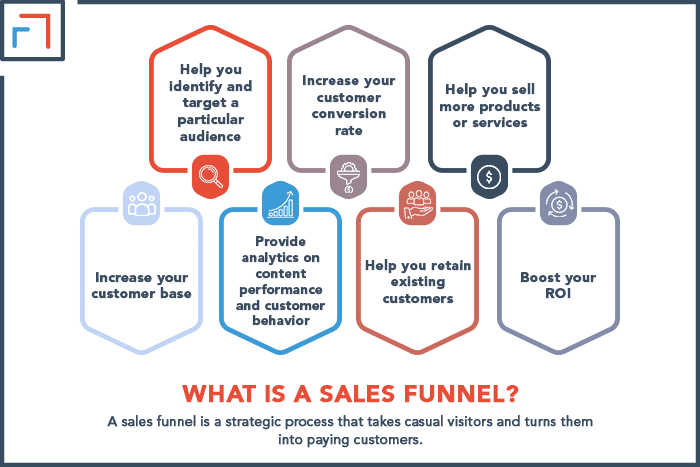
How Do Sales Funnels Compare to Websites?
As you learned in the earlier sections, the main difference between a sales funnel and a website is that a website is a page or group of pages designed to provide information and attract visitors.
On the other hand, a sales funnel is a strategy that’s designed to convert your website visitors into paying customers.
A good sales funnel needs a website or two to go along with it, but not every website is part of a sales funnel.
I’ve covered more on this topic in my article on whether you need a website to deploy a sales funnel.
Now that you understand the basics of websites and sales funnels, it’s time to compare and contrast the two.
1. Active vs Passive
A sales funnel is active, while a website is passive. When someone visits your website, they can browse through your pages at their own pace.
As a result, they may never contact you, or they may bookmark your website and come back later.
A sales funnel is designed to move potential customers through the sales process actively.
It uses a variety of marketing and sales techniques to persuade potential customers to buy from you. This is an important distinction.
A website is an essential tool, but it’s not always enough to generate sales on its own. Sales funnels are created to turn website visitors into customers.
2. One-Time vs Ongoing
Creating a website costs time and money, but you don’t have to do anything else except maintain it once it’s made.
In some cases, it may need a facelift or update, but generally, you can leave it alone once it’s been made.
On the other hand, a sales funnel requires continuous investments and adjustments to be effective.
You must always create new content, design new ads, and run marketing campaigns to move potential customers through the funnel.
Some sales funnel software can automate this process, but you’ll need to be creating the content that is pushed out.
This distinction is vital to understand as it will determine how much time and money you need to invest in your marketing campaign to achieve desired results.
Sales funnels can be quite effective, but they require a lot more effort.
3. Immediate vs Delayed Results
Sales funnels typically produce immediate short-term results, whereas websites produce delayed long-term results.
When someone visits your website, it may take weeks or months before becoming a paying customer.
In some cases, they might not buy anything at all! They may visit other websites during this time, and you may never hear from them again.
A sales funnel can often produce results within days or weeks.
This is because it uses a variety of marketing and sales techniques to persuade potential customers to buy from you.
This means that a sales funnel can be more effective in generating short-term results compared to a website.
Sometimes slow and steady wins the race, but not everyone can afford to wait for long-term results.
Your expectation for results plays a big part in deciding whether a website or sales funnel is the better option for your business.
So make sure you have realistic goals and expectations in mind before investing in either of these marketing tools.
We compiled a table to help you understand some of these differences better:
| POINT OF DIFFERENCE | SALES FUNNEL | WEBSITE |
|---|---|---|
| Purpose | Convert website visitors into customers and increase sales. | Attract visitors, educate, and provide accessible content. |
| Function | Crucial element of your marketing strategy. | Foundation of your digital presence. |
| Timeframe | Short-term investment. | Long-term investment. |
| Strategy | Often used in conjunction with websites/landing pages. | Can be used separately or as part of a sales funnel. |
| Level of Personalization | Very high | Very high (depending on coding skills/ website builders) |
| Risk | High | Low |
| Use Cases | Few | Many |
| Interactivity | Very high | Low |
| Budget | Cheap to create but overall expensive in the long-term. | May be expensive to create but cheap to maintain. |
| ROI | Short-term | Long-term |
| Type of Marketing | Active | Passive |
| Maintenance | High maintenance | Low maintenance |
| Level Of Control | Very high | Somewhat Limited |
| Required Skill Set | Requires users to learn complex software and tools. | Easy to create with website builders. |
The purpose of this chart is to help business owners decide if creating a sales funnel is the right move for them.
If you are unsure, it might be best to start with a website and then move to a sales funnel if it makes sense for your business.
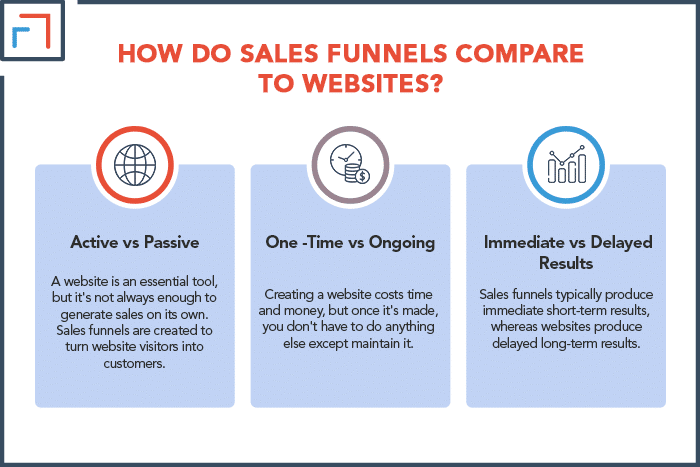
Which Is Better for Your Business – Sales Funnel or Website?
Now that we’ve covered the basics, it all boils down to one question: which is better for your business – a sales funnel or website?
Of course, as a starting point, all businesses should have a website, but the answer to this question depends on the needs and goals of your specific business.
We’ll try to help you decide by outlining the pros and cons of each marketing tool. We will also cover some potential use cases.
Advantages of a Sales Funnel Over a Website
1. Increased Conversion Rate
The average prospect may make it through the marketing funnel before contacting a sales rep up to 90% of the time.
This suggests that a well-planned sales funnel can dramatically increase your conversion rate.
For one company, they even resulted in a 307% increase in the number of successful sales and a dramatic increase in total revenue.
A sales funnel uses a variety of marketing and sales techniques to persuade potential customers to buy from you.
It’s a more effective way to move people through the buying process than relying on someone browsing your website on their own and then contacting you if they’re interested.
Think of your sales funnel as a digital sales rep that’s offering personalized customer service at every stage of the consumer journey.
In contrast, with a website, you are at the mercy of your conversion rate, which you can’t really do much to improve.
In addition, on a typical website, your prospect is on their own.
Their screens provide a never-ending list of distractions that may confuse them and lead them away from your product.
2. Better Audience Targeting
A sales funnel can also help you to target your audience better.
With a website, you rely on people stumbling upon your site organically or through paid ads.
By using a sales funnel, you can target people who have already expressed interest in your product or service.
A sales funnel allows you to track the behavior of website visitors and then helps you target them with content that is relevant to their interests.
For example, let’s say you’re running an online store that sells beauty products for men and women.
On a traditional website, you might target your audience based on gender.
However, with a sales funnel you could target specific groups of people based on their interests. Example:
- Men who are interested in beard grooming products
- Women who are interested in beauty products
This level of audience targeting is insanely difficult with a traditional website.
3. Better User Experience
A sales funnel is designed to provide a positive user experience at all stages of the buying process.
While a website can be used for other purposes, i.e., to provide information about your company, products, or services, it is often designed for selling products or services.
A sales funnel is designed to take your website visitors who are not familiar with your product or service and introduce them to it in a way that is easy to understand.
It does this by walking them through a series of steps that ultimately leads to the purchase of your product or service.
This process makes it more likely for potential customers to buy from you because they are more likely to trust a business that has taken the time to walk them through the buying process.
You can also create a more personalized experience with a sales funnel for your customers.
This is done by providing relevant content that is targeted to their interests.
For example, if a customer abandons the purchase process, you can send them an email with a coupon code to entice them to come back and finish the purchase.
4. Design Flexibility
A sales funnel is extremely flexible and can be easily customized to match your brand.
You can change the colors, fonts, images, and layout to create content in your funnel that’s unique to your business.
This is in contrast to a website, which is more difficult and expensive to redesign once it has been created.
Sales funnel software and tools like ClickFunnels have made this process easier than ever before.
To know about the full potential of ClickFunnels, you can check out my article on what all can ClickFunnels do?
With the help of these tools, you can create a high-converting sales funnel in minutes without any design or coding experience.
The freedom to do this on a website is limited as most design changes are complex and usually require the help of a web developer.
Even if you are using customizable themes and plugins, that level of freedom is simply not there unless those themes allow you to work with drag and drop builders, which are essentially emulating sales funnel tools only.
You also have more control over the design and messaging of your sales funnel than you do on your website.
For example, you can test different headlines, CTA buttons, and product descriptions to see which ones produce the best results.
5. All-In-One Marketing Tool
With a sales funnel, you can enjoy the perks of having an all-in-one marketing tool. It includes everything you need to sell your product or service online.
This usually includes:
- A website to host your sales funnel.
- Landing pages to capture leads.
- Email marketing software to contact leads and customers.
- Sales pages to sell your product or service.
- A payment gateway to process payments.
This all-in-one approach makes it easier for business owners to get started with online marketing of their business.
However, the situation is different when you solely rely on a traditional website. You don’t have all of these components built-in.
Instead, you have to piece together different tools and services to create a complete marketing toolkit. This can be expensive and frustrating.
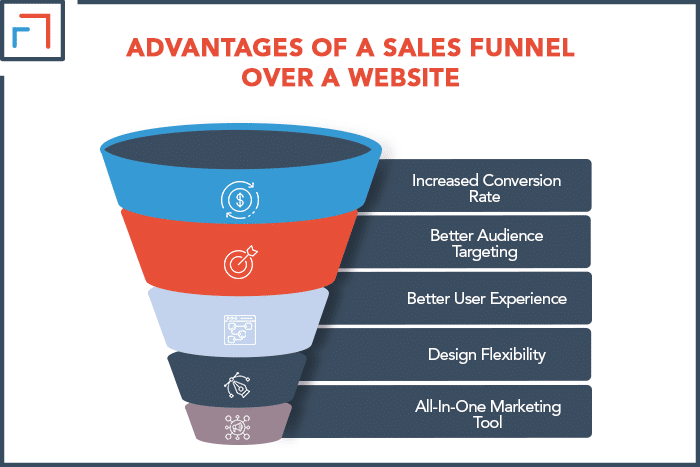
Sales Funnel – Pros and Cons
Advantages
- Easy to set up and use with sales funnel software
- Targets specific leads who are already interested in your product
- Can increase sales quickly
- Higher ROI potential in the short-term
- Offers optimum design flexibility
- Serves as an all-in-one marketing tool
Disadvantages
- May be difficult to learn and use correctly
- Sales funnel software can be expensive
- Requires high maintenance
- High-risk investment
- Requires paid advertising to be effective
- Not ideal for lead generation
Advantages of a Website Over a Sales Funnel
1. Less Expensive
You will often need additional sales funnel software and tools to create effective landing pages and capture leads to drive maximum benefits from a sales funnel.
Unfortunately, this can increase your costs. For example, ClickFunnels starts at $97/month.
This is in contrast to a website, which is generally much cheaper to build and does not require any additional software or tools (unless you want to use paid plugins or email marketing services).
In fact, you can create a professional-looking website for a reasonable amount using a website builder like Wix or Squarespace.
With a bit of a learning curve involved, you can even create one using WordPress for next to almost nothing.
Another way websites save you money is by not requiring you to pay for traffic.
Instead, you can use organic SEO techniques to get free, long-term traffic that will eventually convert into leads and customers.
In contrast, sales funnels require paid advertising to be effective, which quickly gets expensive.
This stems from the fast-acting nature of sales funnels, where you are trying to get sales as fast as possible.
Getting high traffic volumes at that pace usually requires you to run some kind of ad campaign, which can be costly.
2. Better Reach
A website can reach a much larger and broader audience than a sales funnel.
This is because a website can be found by anyone who is searching for the products or services you offer online.
This includes people who are not actively looking for your product or service.
They may just be interested in what you have to offer and are comparing you with competitors.
Sales funnels usually target people who are actively looking for a solution to their problem and are already familiar with your product or service.
They’re more narrow and targeted, so they sometimes miss out on the bigger picture.
While this strategy increases your chances of making a sale, it also means that you are not reaching as many people as you could with a website.
This is something that is especially important for businesses that are just starting out.
3. Flat Learning Curve
Sales funnel software and tools like ClickFunnels can be difficult to learn for some people, especially if you are a beginner.
You will need to learn how to use the software and track the data correctly to make the most of your funnel.
This can be frustrating and discouraging, which may lead to you abandoning your funnel altogether.
On the flip side, a website is relatively easy to use and does not require special knowledge or skills to run.
Using a website builder, you can create a website in minutes and start publishing content immediately.
A professional can handle the more tricky parts of website creation, such as coding and design if you don’t have the time or skills to do it yourself.
4. Financially Less Riskier Investment
When you build a website, you are making a long-term investment. It will take time and effort to rank your site on search engines and attract visitors.
However, once you have achieved this, your website will continue to generate traffic and leads for years to come.
On the other hand, a sales funnel is a more risky investment. If your funnel is not practical, you could lose a lot of money.
In addition, the ROI in the long-term is often not as good as a website, and it can be difficult to recoup your costs if the funnel is not successful.
This is not an ideal situation to be in, especially if you are a small business with limited resources.
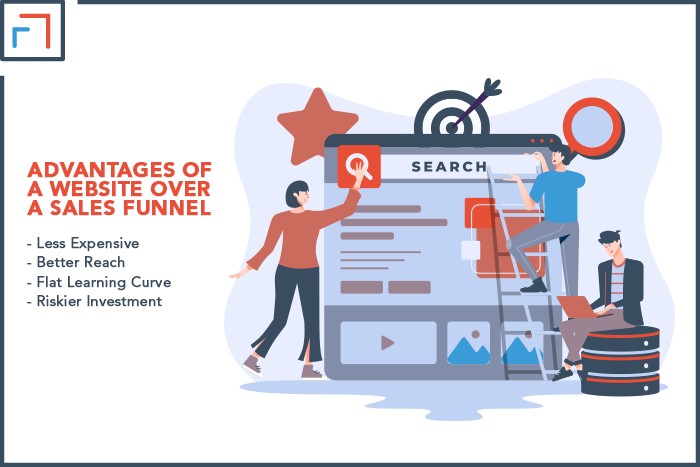
Website – Pros and Cons
Advantages
- Inexpensive to build
- Reaches a much larger audience
- Easy to use
- Generates traffic and leads for years to come
- Minimum risk investment
Disadvantages
- Takes time and effort to rank above others on search engines
- May not be the best option for small businesses
- Sometimes requires additional plugins and services to function as a marketing tool
Sales Funnel vs. Website – Use Cases
Now that we have looked at the pros and cons of using a sales funnel over a website, let’s look at some specific use cases where each would be the better option.
Use Case #1: You Are An E-Commerce Store
If you are an e-commerce store, there are two routes you can take:
1. Website + E-Commerce Store Plugin
The first option is creating a website and using an e-commerce store plugin, like WooCommerce.
This is a good option if you have multiple listings and want to create a complex e-commerce store.
It will help minimize the development time and cost, and you will have full control over your website and store.
However, you will need to learn how to use the plugin and track the data correctly to make the most of your store.
2. Sales Funnel
The second option is to use a sales funnel. This option is better if you want to focus on one or two products and create a high-converting sales funnel.
The key benefit of this option is that you will be able to specifically target your audience and improve their user experience by offering fewer options (read: distractions), leading to higher conversion rates.
Plus, you will have access to all the powerful sales funnel software and tools, which can help you increase your conversion rate.
However, as mentioned earlier, the learning curve can be steep, and you may not have the time or skills to use these tools correctly.
Use Case #2: You Are A Service Provider
A website is a better option for a service provider, as it is easier to generate leads and then sell services.
If you are a service provider, such as a plumber, electrician, or consultant, your website should focus on generating leads rather than sales.
You can use a lead generation tool, like WPForms, to create a custom form and capture leads from your website.
You can also use a lead magnet, like an ebook or guide, to capture email addresses from visitors. This is a great way to grow your email list and get more leads.
Once you have captured the lead’s information, you can follow up with them via email or phone and offer your services.
A sales funnel is not the best option for service providers, as it is difficult to sell your services online.
It is hard to return a service compared to a product, as it is consumed right from the get-go.
Word of mouth is also powerful for service providers, so concentrating on getting more leads (through a website) increases your chances of making a sale.
Use Case #3: You Are A Startup
If you are a startup, it’s best to start with a website in the initial stages. This will allow you to showcase your product or service and generate leads.
A website is the best way to introduce your startup to the world. In the early stages, your goal as a startup is to gather leads and validate your product or service.
A website is perfect for that. You can create a basic website for a low cost using online tools like Wix or Squarespace.
These websites are easy to use and allow you to create a professional website without any coding knowledge.
You can also add a lead capture form to your website so that you can collect email addresses from potential customers.
This is a great way to start building your list of leads. My article on lead collection will help you learn ‘where can you collect emails‘.
Once you have a website, some content, and effective ads, you can then start using a sales funnel to convert these leads into actual buyers.
This is the most suitable path for a startup because it allows you to increase your conversion rate and eventually turn a profit slowly.
Use Case #4: You Are Selling a High-Ticket Item
In this case, a sales funnel is the best choice because high-ticket items require more effort to sell.
You need to create a buying process that takes the buyer through all the steps necessary to purchase.
You will need to convince them much more consistently than if you were selling a lower-priced item.
A sales funnel will help you do this better by controlling the buying process.
You can ensure that the buyer is fully aware of what they are buying and understand the value of the product.
You can also use a sales funnel to overcome objections.
If the buyer has any doubts about making a purchase, you can address them in the buying process and help to assuage any fears they may have.
A sales funnel will also help you to close more sales.
Because the buying process is under your control, you can ensure that the buyer is ready to buy by the time they reach the checkout page.
This will increase your chances of making a sale. However, relying on a sales funnel alone is not enough.
You also need a good website to support your marketing efforts.
A good website will help you attract more buyers to your funnel and help you close more sales.
If it looks professional, they’ll be more likely to believe the value of your product. So, while it’s critical to use a sales funnel, don’t forget about your website.
A good website is essential for any business and should be a key part of your marketing strategy.
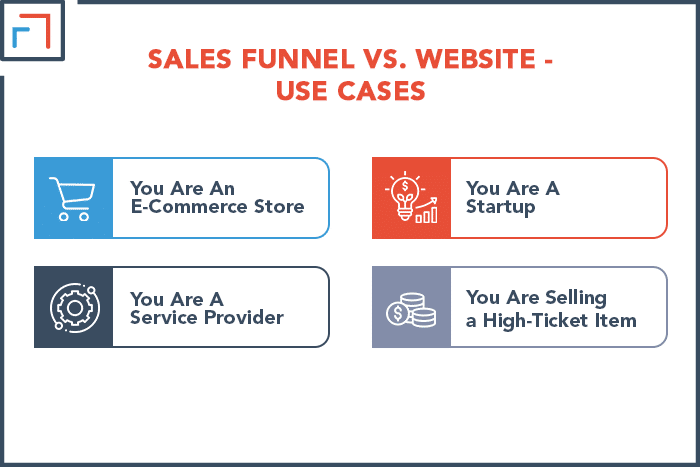
Usually, a Sales Funnel is Not Better than a Website BUT…
So, is a sales funnel better than a website? In most cases, the answer is no.
A website is a better option for most businesses, as it is a good way to generate leads and sell products or services.
A sales funnel is a more risky investment and is not as effective as a website in most cases.
However, there are some specific use cases, for example, high-ticket products or services, where a sales funnel may be more effective.
If you’re unsure about where to begin, it may be best to start with a website and then move on to a sales funnel if you feel it’s necessary for your business.
